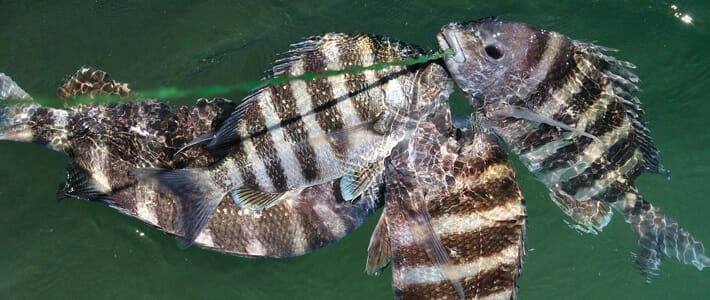Sheepshead

Archosargus probatocephalus
The scientific name of the sheepshead is long and somewhat cumbersome, Archosargus proba-tocephalus. The first name, or genus, and second name, or species, are derived from Greek, with the latter (probatocephalus) being a composite of probato = sheep and cephalus = head. The species name can be broken down into archo = chief and sargus = porgy. Putting this together, you get the chief porgy with the sheep’s head, or more commonly, the sheepshead.
Product pdf for download-
3 oz. (100g) raw, edible portion
-
Calories 257
-
Calories from Fat 52
-
Total Fat 5.74
-
Saturated Fat 1.449g
-
Cholesterol 119mg
-
Sodium 169mg
-
Carbohydrates 0g
-
Potassium 962mg
-
Protein 48.1g
Harvest Method
Annual commercial catches of sheepshead are from cast nets and hook and line fishing.
Flavor
This fish has a wonderful flavor, much like crab or lobster.
Texture
The texture of this fish is firm with a fine flake.
Market Segments
Appropriate in the casual dining, fine dining, hotel, and resort/club segments of the market.
Preparation
Good methods for cooking sheepshead fish include frying, sautéing, pan broiling, grilling, and baking. Sheepshead can also be used in soups and chowders, and they can even be used to make imitation crab meat.
Because sheepies are very lean, they need to be cooked with fat of some sort. This might be butter, margarine, bacon drippings, olive oil, or vegetable oil. The fillets don’t have to be marinated, but marinating will add some extra flavor. If the fish fillets are placed in a marinade, they need not be left long; an hour is usually sufficient.
Distinguishing Characteristics
Sheepshead is similar in features to a black drum. It is silvery in color with five or six distinct vertical black bands on its sides, and not always the same on both sides. Sheepshead has prominent teeth, including incisors, molars, and rounded grinders, and strong and sharp spines on dorsal and anal fin.
Other Information
They range from one to two pounds while inshore, and commonly weigh eight pounds while offshore
Interesting Fact
This small, spiny fish is a notorious bait stealer when fishermen use live shrimp around oyster bars. Their coloration along the flanks – vertical black bars and light-colored silvery spaces between them – resemble patterns of the clothes worn by convicts working on the chain gangs of old. There is no doubt that the fish’s appearance is appropriate for its behavior around a baited fish hook.
Source
Inshore, sheepshead is found around oyster bars, seawalls, and in tidal creeks. They move nearshore in late winter and early spring for spawning, gathering over debris, artificial reefs, and around navigation markers.
Sheepshead are a recreational and commercial species found along the southern coast of the United States. In states where anglers catch sheepshead, they fish around hard structures to which barnacles, oysters, and mussels attach and provide hiding places for small crabs. Because of their strong fighting ability and the fine taste of their firm, white flesh, this species is a highly prized catch.
Cooking Tips
Like most lean fish, sheepshead cook quickly, so it’s easy to overcook them. When the flesh is cooked for too long, it can get dry and somewhat tough. How can you tell when whole sheepies are done? Watch the backbone – the meat will draw away from the backbone. The flesh on whole dressed fish and in fillets will turn from almost clear to white when completely done.